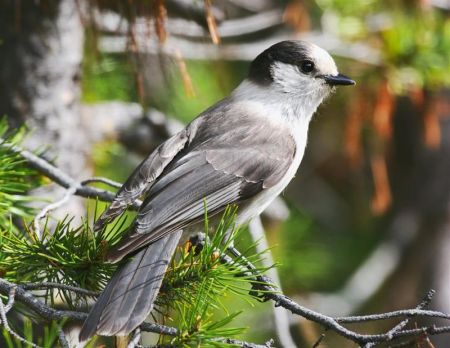Sbarnhardt (talk | contribs) (edit for alignment) |
Sbarnhardt (talk | contribs) (FA changed to Canada Jay for August of 2024) |
||
| Line 1: | Line 1: | ||
| − | <div style="{{psubheader}}">Featured Article: '''[[ | + | <div style="{{psubheader}}">Featured Article: '''[[Canada Jay]]'''</div> |
| − | [[Image: | + | [[Image:Grey Jay.jpg|thumb|450px|left|A bird of the ''obscurus'' group<br />Photo © by {{user|digitalbirder|digitalbirder}}<br />Manning Park forest, [[British Columbia]], [[Canada]], 11 May, 2005]]] |
==Identification== | ==Identification== | ||
| − | + | 27 - 31cm, A small, variable jay of the forest of North America. Generally small-billed and with a fluffy appearance. | |
| − | |||
| − | |||
| + | '''Nominate subspecies''' | ||
| + | White to light greyish-white forehead, forecrown, face, neck and upper breast | ||
| + | black to dark brown central crown to nape | ||
| + | Slate-grey upperparts | ||
| + | Light grey underparts | ||
| + | <br /> | ||
| + | '''capitalis''' | ||
| + | <br /> | ||
| + | Paler, with a much paler head than nominate | ||
| + | <br /> | ||
| + | '''obscurus''' | ||
| + | <br /> | ||
| + | Dark on head extends to forecrown | ||
| + | Contrastingly dark above and pale below | ||
| + | <br /> | ||
| + | |||
| + | The other subspecies are intermediate between the three mentioned. sexes are similar, males larger than females, juveniles are much darker than adults | ||
| + | <br /> | ||
==Similar Species== | ==Similar Species== | ||
| − | + | Looks superficially similar to [[Clark's Nutcracker]]. | |
| + | <br /> | ||
==Distribution== | ==Distribution== | ||
| − | + | [[North America]]:<br /> | |
| − | + | [[Canada]]: [[Alberta]], [[British Columbia]], [[Manitoba]], [[New Brunswick]], [[Newfoundland]], [[Labrador]], [[Nova Scotia]], [[Northwest Territories]], [[Ontario]], [[Prince Edward Island]]<br /> | |
| + | [[United States]]: [[Alaska]], [[Arizona]], [[California]], [[Colorado]], [[Idaho]], [[Massachusetts]], [[Maine]], [[Michigan]], [[Minnesota]], [[Missouri]], [[Montana]], [[New Hampshire]], [[New Jersey]], [[New Mexico]], [[New York]], [[Oklahoma]], [[Oregon]], [[South Dakota]], [[Utah]], [[Vermont]], [[Washington]], [[Wisconsin]], [[Wyoming]] | ||
| + | <br /> | ||
==Subspecies== | ==Subspecies== | ||
| − | + | 8 subspecies recognized by Clements, which are spread across certain areas of Alaska, Canada, and the contiguous US. | |
| − | + | ||
==Habitat== | ==Habitat== | ||
| − | + | Coniferous and mixed forest of the taiga and high mountain elevations. Recorded at 2440 - 3050m in the Rocky Mountains. | |
==Breeding== | ==Breeding== | ||
| − | + | ||
| + | Breeding season starts already in late winter (February) and goes to April. Two birds stay permanently together. The nest is a bulky platform made of twigs and well insulated. It's placed 1.7 to 15m above the ground, close to the trunk of a spruce or fir tree. Lays 3 - 4 eggs. | ||
| + | |||
==Diet== | ==Diet== | ||
| − | + | Feeds on beetles, bugs, other insects, spiders, berries, fungi and sometimes on small birds, frogs, snakes, mice or other vertebrates. Takes also carrion. Produces a sticky saliva with which it glues together berries and other food items into balls for easier winter storage, like its relative the [[Siberian Jay]]. | |
| + | |||
| + | ==Movement== | ||
| + | |||
| + | A resident species. Most pairs stay in their territory for their whole life. | ||
| + | |||
| + | |||
| + | |||
| + | |||
| − | '''[[ | + | '''[[Canada Jay|Read Full Article.......]]'' |
Revision as of 13:24, 1 August 2024

Photo © by digitalbirder
Manning Park forest, British Columbia, Canada, 11 May, 2005
]
Identification
27 - 31cm, A small, variable jay of the forest of North America. Generally small-billed and with a fluffy appearance.
Nominate subspecies
White to light greyish-white forehead, forecrown, face, neck and upper breast
black to dark brown central crown to nape
Slate-grey upperparts
Light grey underparts
capitalis
Paler, with a much paler head than nominate
obscurus
Dark on head extends to forecrown
Contrastingly dark above and pale below
The other subspecies are intermediate between the three mentioned. sexes are similar, males larger than females, juveniles are much darker than adults
Similar Species
Looks superficially similar to Clark's Nutcracker.
Distribution
North America:
Canada: Alberta, British Columbia, Manitoba, New Brunswick, Newfoundland, Labrador, Nova Scotia, Northwest Territories, Ontario, Prince Edward Island
United States: Alaska, Arizona, California, Colorado, Idaho, Massachusetts, Maine, Michigan, Minnesota, Missouri, Montana, New Hampshire, New Jersey, New Mexico, New York, Oklahoma, Oregon, South Dakota, Utah, Vermont, Washington, Wisconsin, Wyoming
Subspecies
8 subspecies recognized by Clements, which are spread across certain areas of Alaska, Canada, and the contiguous US.
Habitat
Coniferous and mixed forest of the taiga and high mountain elevations. Recorded at 2440 - 3050m in the Rocky Mountains.
Breeding
Breeding season starts already in late winter (February) and goes to April. Two birds stay permanently together. The nest is a bulky platform made of twigs and well insulated. It's placed 1.7 to 15m above the ground, close to the trunk of a spruce or fir tree. Lays 3 - 4 eggs.
Diet
Feeds on beetles, bugs, other insects, spiders, berries, fungi and sometimes on small birds, frogs, snakes, mice or other vertebrates. Takes also carrion. Produces a sticky saliva with which it glues together berries and other food items into balls for easier winter storage, like its relative the Siberian Jay.
Movement
A resident species. Most pairs stay in their territory for their whole life.



